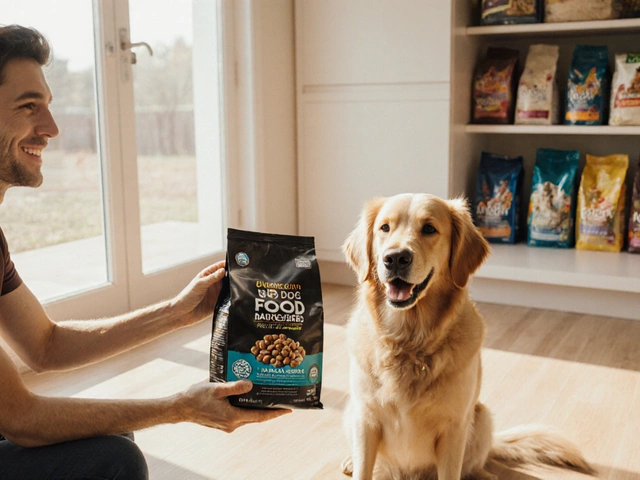Ever stare at a row of dog supplements and feel totally lost? You’re not alone. There’s everything from joint chews to skin oils, all promising miracles. But here’s the trick: not every supplement is right for your dog. Before tossing anything into your cart, think about what your dog actually needs. Is your pup itching all the time? Does he slow down after a short walk? Zero in on real issues before buying anything.
Not every dog needs extra vitamins or magic powders—sometimes their food already covers the basics. Brands like to make big promises, but what really matters is if the product is safe and useful for your pet’s unique needs. I’m breaking down the key things you need to check before picking that next bottle or bag. Let’s keep things simple and smart—your dog deserves it!
- Understanding Your Dog's Needs
- Reading the Label Like a Pro
- Safety Checks and Red Flags
- Vet Recommendations and Real-World Tips
Understanding Your Dog's Needs
The truth is, dogs are a lot like us. Their age, activity level, breed, and even the region where you live can change what they need from a supplement. For example, older pups are more likely to have creaky joints, while younger ones might need help with skin or coat issues. Before grabbing anything off the shelf, take a hard look at your dog's daily life and health history.
Some issues that send people rushing to buy a supplement usually show up in a handful of ways. Here are some common dog health areas where supplements get used:
- Joints and mobility (for example, dogs that limp, struggle with stairs, or slow down too soon)
- Skin and coat (like scratching, shedding, or dry skin spots)
- Stomach and digestion (loose stools, bad gas, or finicky appetites)
- Immune system boost (dogs that catch everything or are always run down)
But be careful—dog supplements are not cure-alls. They work best when you actually match them to a true need. A large 2023 survey from the American Pet Products Association showed over 67% of dog owners give supplements for joints, but less than half had gotten advice from a vet first. That’s a lot of guesswork for something that affects a pet’s health!
Wondering what’s really normal and what’s a sign your dog could use some help? Here’s a quick cheat sheet:
| Dog Factor | What to Watch For | Possible Supplement |
|---|---|---|
| Age (over 7 years) | Slowing down, stiffness | Joint or mobility blends |
| Puppies (under 1 year) | Growth spurts, sensitive tummies | Digestive or immunity support |
| Skin/Coat Condition | Excess scratching, dull fur | Omega-3s, fish oil |
| Diet type (homemade/limited) | Potential missing nutrients | Multivitamin, specialty blends |
The best place to start? Jot down your dog's main health quirks or changes you’ve seen lately. That way you’re not just chasing trends—you’re finding a dog health supplement that actually gives your buddy a boost where it matters.
Reading the Label Like a Pro
If you want to find a good dog health supplement, the label holds all the secrets. Ignore the flashy branding for a second—flip that bottle around and check the details. The ingredient list comes first. This should be clear and specific. Look for exact names, like "glucosamine hydrochloride" or "salmon oil," not vague stuff like "proprietary blend" or "natural flavors." Those don’t really tell you what’s inside.
The order of ingredients also matters. Ingredients at the top are more plentiful, so if the main thing that’s advertised doesn’t show up until the end, it’s probably just a sprinkle. Another tip: check if active ingredients show the exact amount, not just a percentage. You want numbers like “250 mg of glucosamine per chew”—that’s how you know what your dog is actually getting. Steer clear of mystery fillers and artificial dyes. Those aren’t helping anyone, especially a dog with allergies or skin issues.
Here’s an easy list to keep handy when checking any supplement label:
- Actual ingredient names—no vague stuff
- Exact amounts per serving
- No weird additives or artificial colors
- Expiration date clearly shown
- Manufacturer’s contact info and quality seals (like NASC or third-party labs)
One survey found that around 25% of pet supplements didn’t even meet their label claims for ingredient levels. Good brands have nothing to hide and will show proof of testing.
| Label Detail | Why It Matters |
|---|---|
| Active ingredient (with amount) | Tells you if the dose is enough for your dog’s size |
| Third-party testing or seal | Means what’s inside has been verified safe |
| Expiration date | Old supplements can lose power and become unsafe |
| Manufacturer contact | If you can’t call, that’s a red flag |
Always check for a lot number or batch code, too. That means they’re tracking quality and can recall a batch if something goes wrong. Quick checks like these protect your dog from pretending supplements and cheap fillers.

Safety Checks and Red Flags
So you’ve narrowed down the field, and now it’s time to get real about safety. Not every supplement on the shelf is a good pick, and there’s no sense risking your dog’s health for a fancy label or a trendy buzzword. Here’s what you absolutely need to check.
- Check ingredient quality: Look for supplements with clear ingredient lists. If the ingredient list is full of stuff you can’t pronounce, or the product is hiding behind “proprietary blends,” be suspicious. Honest brands list real, useful ingredients like glucosamine, fish oil, or probiotics—with actual amounts.
- Certification matters: In the U.S., look for products made in facilities that follow Good Manufacturing Practices (GMP) or are certified by the National Animal Supplement Council (NASC). You’ll sometimes see the NASC Quality Seal—this means there’s been some quality oversight, which is a good thing for your pet.
- Watch for recalls: Dog supplements are not immune to recalls. Before you buy, pop the brand name and “recall” into a search engine. You’d be surprised how often trouble pops up.
- Buy from trusted sources: Don’t grab just anything online. Trusted pet stores or your vet’s office are much safer bets than random online marketplaces.
Now for some facts that might shock you: a 2023 independent lab study found that 25% of tested pet supplements had ingredient levels way off from what the label said, and nearly 15% contained contaminants like heavy metals. That’s a wake-up call for double-checking what you’re buying.
| Safety Tip | Why it Matters |
|---|---|
| Look for the NASC seal | Indicates quality control and transparency |
| Verify ingredients and dosages | Prevents accidental overdosing and unknown substances |
| Check for recent recalls | Avoids risky products that might be unsafe |
| Ask your vet before starting | Reduces risk of negative reactions or useless extras |
And here’s something else: supplements for dogs aren’t regulated nearly as tightly as prescription meds. That’s why reading up and asking questions is so important. Never assume “natural” means “safe.” Even common ingredients like garlic or xylitol—safe for humans—can be harmful, even deadly, for dogs. When in doubt, skip it or ask your vet first.
Bottom line? The safest dog health supplements come from transparent brands, have clean ingredients, and don’t promise the world. If anything looks sketchy, don’t ignore your gut feeling. Your dog’s health isn’t worth the gamble.
Vet Recommendations and Real-World Tips
Before starting any supplement, vets say: don’t skip the checkup. Nobody knows your dog’s health like your vet. Supplements can sometimes mess with meds, or be totally useless if your dog’s diet is already balanced. That’s why about 7 out of 10 vets want owners to ask before grabbing something new off the shelf.
Here’s what vets actually recommend when it comes to dog health supplements:
- Always check for third-party testing. Trustworthy brands will share test results from groups like the NASC (National Animal Supplement Council) or NSF International. This helps you dodge cheap copycats or tainted products.
- Stick to single-ingredient formulas at first. If your dog doesn’t react well, it’s easier to ID the culprit. Combo blends make it tricky to pinpoint issues.
- Avoid human supplements for dogs. Just because something works for people doesn’t mean it’s safe for pets. Xylitol, for example, pops up in some human supplements but is toxic to dogs.
- Be cautious with dosages. A 10 lb dog doesn’t need the same amount as a 75 lb lab! Use measuring spoons and never guess.
Everyday dog owners have some real stories, too. I’ve met quite a few who switched brands after noticing weird rashes or tummy troubles from cheaper products. One popular online survey last year found that about 46% of owners started a supplement just on the advice of a friend—not a pro. That’s a quick recipe for disappointment and sometimes scary side effects.
| What Can Go Wrong? | Potential Result |
|---|---|
| Human supplement ingredients | Poisoning, ER visits |
| Unverified online brands | Ineffective, sometimes harmful |
| Mega-doses of vitamins | Upset stomach, organ strain |
| Stacking too many supplements | Overlap and dangerous interactions |
If your dog’s on the fence—a little stiff, kinda itchy, not super perky—track the small stuff. Keep notes in your phone. Did the new supplement help, or did the issue stick around? A quick video or picture can also help your vet spot side effects you might miss. And don’t stress if nothing changes overnight. Most experts agree it can take 4–8 weeks for high-quality supplements like glucosamine or fish oil to show results.
Final pro tip: if you’re ever unsure, bring the supplement bottle to the vet. They’ll scan the ingredients, check for weird fillers, and tell you if you’re on the right path. Your dog’s not just a pet—they’re family, and deserve solid info, not risky guesses.





